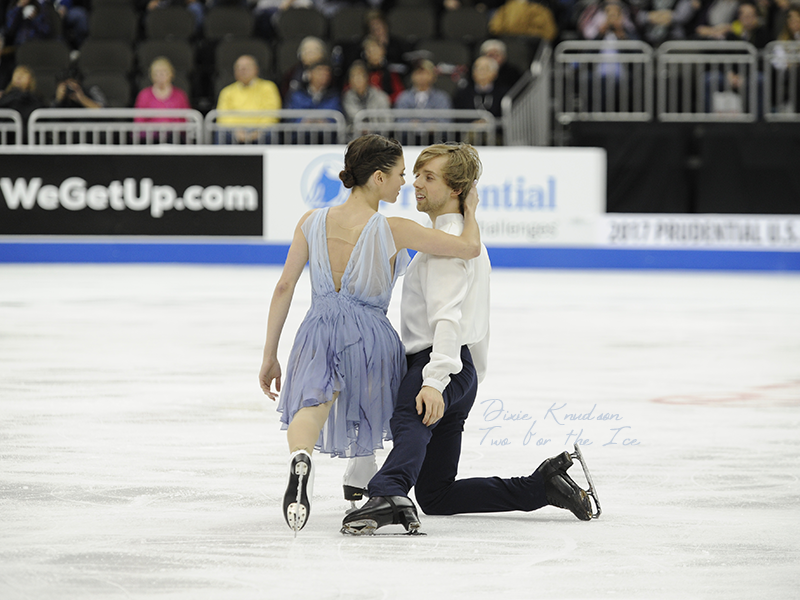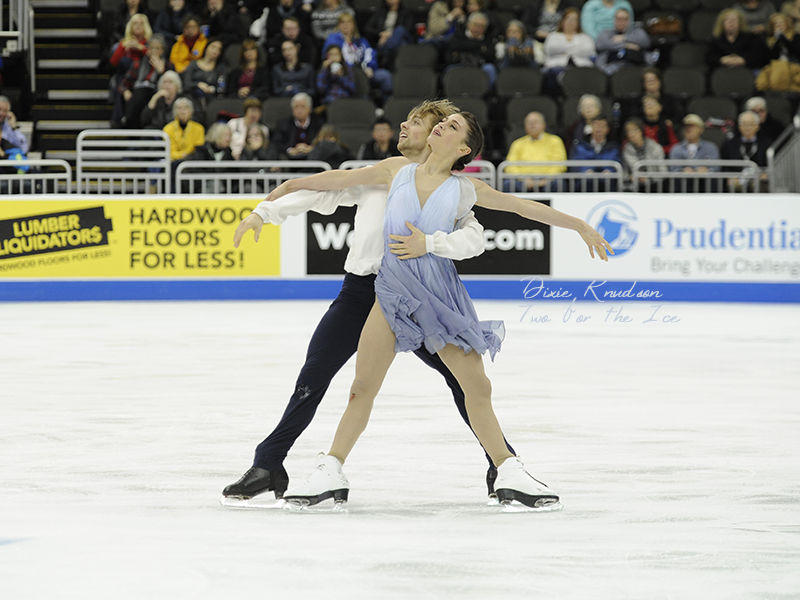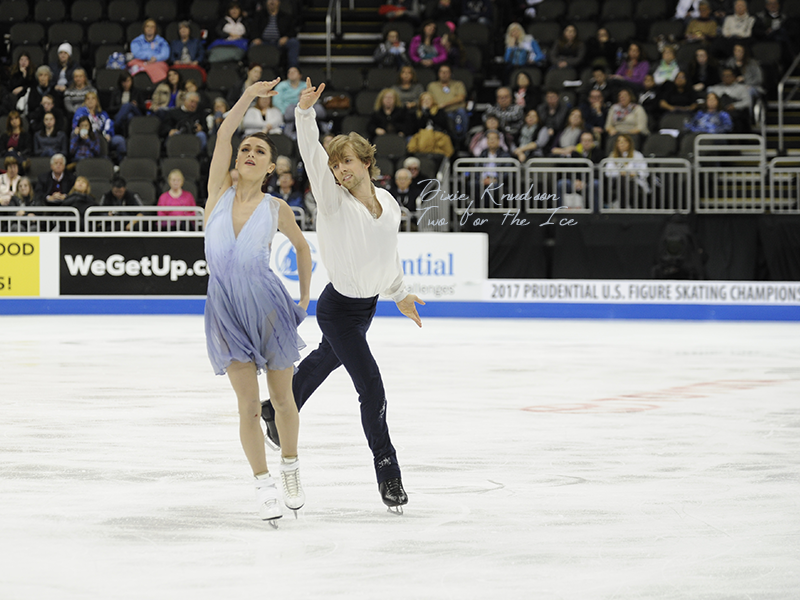by Jacquelyn Thayer
24 hours.
That’s approximately how much time passed, after a troubled free dance performance at the 2017 U.S. Figure Skating Championships, before Kaitlin Hawayek and Jean-Luc Baker seriously mulled the possibility of bringing back — or, rather, keeping with — their well-received Liebestraum free dance for the Olympic season.
“We had a meeting the next morning and we thought about it and we thought it just seemed like the right thing — the right play for us, the right plan,” said Baker. “While we were there, we actually talked to a couple judges and just asked what their thoughts were behind it, and they were quite intrigued by the idea as well. And it just seemed like the right move.”
Though retaining a piece of choreography for two or so seasons is relatively common in singles and pairs — often the better to ease a skater into upgraded technical content from one year to the next — it’s significantly more unusual in ice dance, where creativity, or the suggestion thereof, is especially prized. Original and short dances have by necessity changed year to year as rhythms and patterns switch up annually, but free dances, too, tend to change with the season; it’s been cause for note when a team, like France’s Nathalie Pechalat and Fabian Bourzat at the 2010 World Championships, has revived an older program late in the year after less-than-desirable results with a new piece.
So it might be surprising, then, to learn that these dancers were not alone in their musings.
“We asked one of our secondary coaches what they thought about the idea and she was laughing because [primary coach Angelika Krylova] had asked her as well, like, what do you think about that idea,” he continued. “And we hadn’t talked to Angelika about it at all and no one else had talked to her.”
So one day soon after the competition, while Krylova worked with another team, Hawayek and Baker seized a few moments to ask her take firsthand. “And she’s like ‘Yes, absolutely. Let’s do it,’” said Baker. “She had a big smile on her face and from that moment, she didn’t even have an ‘Oh, I don’t know.’ It was like an ‘Absolutely. Let’s do it.’”

Hawayek and Baker perform in the free dance at the 2017 U.S. Figure Skating Championships. Photo by Dixie Knudson.
The program initially emerged from a period of reflection for the team. After receiving some critical feedback on 2015-16’s Theory of Everything free — a program that offered significant skated complexity and musical nuance, but also, some in the sport felt, relied too much on its underlying storyline — the team was ready to crystallize skating itself: abstract music, clean shaping, an open narrative. They ran through a few musical selections before zeroing in on Franz Liszt’s signature composition.
“And the reason that we chose it is because we felt like it was the perfect canvas to just create a program that was admired for just its purity — the music is pure and we wanted to just show pure skating compared to an intricate storyline or extreme emotions,” said Hawayek. “We just wanted it to be able to feel like a genuine emotion that evolved through our skating — just the joy that you have when you skate, and we wanted people to feel that.”
Similarly, the creative process with coach Pasquale Camerlengo was an organic one. “We start and we finish whenever it feels done to us,” she continued. “The great thing about working with Pasquale is that we really work as a unit — it’s not like a choreographer giving us steps that we should just learn to do. We work with Pasquale and we give our impressions and we give our own creativity to it as well.”
“At the end of the day, we’re the ones skating it, but he definitely has an idea in his head — but his idea isn’t necessarily fixed,” said Baker. “It’s not ‘this,’ period. It’s oftentimes, this is my idea; now let’s see how we can manipulate it and let’s see how we can form this into something that is you.”
During the initial choreographic process, Baker relates, one suggestion — a mid-program stop — met with early reluctance. “Kaitlin and I had this idea which we came together on, and I remember telling Pasquale and he was like, oh, I don’t know,” said Baker; Camerlengo preferred ongoing motion. “And I’m like, no, let’s have this moment be a moment for the audience to just enjoy and, like Kaitlin said, show just an enjoyment of a program. Not having a set storyline, but allowing the audience member to really interpret it how they would like to.”
The skaters won that battle — as evidenced around 3:29 in the video above — providing, along with their picturesque spread eagle sequence, a particular boon to photographers. And when I mention that advantage to the team, it proves to have been little accident.

Hawayek and Baker perform in the free dance at the 2017 U.S. Figure Skating Championships. Photo by Dixie Knudson.
In retaining Liebestraum, the idea is to stick with a good thing, a relatively proven entity. But some freshening is still required, and to perfect the material, the two are working particularly closely with ballet and Gyrotonic instructor Veronique Breen, a long-time member of their coaching crew.
“Our main focus is to find connections between their movements and their emotions,” said Breen. “Working on symmetry of movements, coordination and connections in the partnering positions, finding organic ways to move in a more contemporary dance way. All these are also helping into adding more power and edges.”
The work has come on both floor and ice. “Off ice, we do Gyrotonic, privates and duets,” she continued. “The technique allows to stretch and strengthen at the same time. It helps getting more control into the spine and core, understanding also the breathing patterns to help all movements. On ice, we focus on feeling the movements, making them organic and finding the similarities with Gyrotonic and dance port de bras.”
“I think that in general, it’s not only from a visual standpoint of making lines and certain images more crystal clear and just kind of detailing the heck out of it,” said Hawayek. “We’re trying to make the connection and just the interpretation even more genuine than it was, make it feel more personalized. I think we’re just trying to develop it even more than it was last year.”
Feedback last season was positive, with officials advising the team to simply continue growing the material. Still, small tweaks now — minor adjustments that, both say, will likely stand out only to the free dance’s most ardent admirers — help keep the training process novel.
“There absolutely will be some new elements in there, some new little things here and there, which are subtle enough to recognize to the naked eye, but also just to keep it fresh for ourselves,” said Baker. “It’s really refreshing again to be training it and it feels very comfortable.”
“It keeps it new and exciting for us as well,” agreed Hawayek. “It’s a program that’s close to our heart and we didn’t want to change it too much that it felt like an entire different program for us, but kind of got a reinvigorated and a renewed excitement for it with some little changes.”
And Breen’s contributed to the ever-collaborative choreographic process. “I have reorganized some of the choreography,” she said. “Arranged the lines or directions of their bodies — changed arms mainly. What was there, we made it better, or so I hope and think.”
The overall impression, though, should remain unchanged, and while costumes were still under discussion at time of interview, Hawayek believes any potential adjustment there will be “minuscule.”
But having still saved a bit of off-season work on the free dance — no hours spent picking through music, piecing together a wholly new work, and building muscle memory from scratch — they’ve dedicated that extra time to a short dance centered on the deceptively simple rhumba.
The top-seeded U.S. trio of Maia and Alex Shibutani, Madison Chock and Evan Bates, and Madison Hubbell and Zach Donohue carry the edge of experience. “They’ve all been senior for years and years, and they’ve competed the rhumba once, if not twice,” said Hawayek. She and Baker only entered the senior ranks in 2014; the pattern was last used in 2011-12’s senior short dance. “We’ve kind of already felt like they had a little bit of a preview of the season, so by giving ourselves more time to work on the short dance, we feel like we’re at par with them and [can] push back just as much in pushing the dance.”
In that 2011-12 season, rhumba key points bedeviled the world’s top teams; only two couples, ranked fifth and seventh, managed to pick up a single Level 4 sequence apiece at 2012’s Four Continents Championships, while the likes of Meryl Davis and Charlie White and Tessa Virtue and Scott Moir achieved the feat at only one and two internationals, respectively. Hawayek and Baker are steeling themselves for the battle. “It’s still going to be very difficult — you’ll definitely see who can skate and who can’t skate,” said Baker. “What looks simple is very, very difficult in terms of making sure the maneuvering of it’s done correct.”
“It’s pure skating skills,” added Hawayek. “You stay in hold the entire time and there’s not any crazy hopping and jumping around. In the sense of watching it, it looks very basic, but because of that simplicity of it, you need to be able to have super strong fundamentals for your skating, and I think it’ll separate the teams that kind of rely on tricks and those who have a really great base of skating skills behind them.”

Hawayek and Baker perform in the free dance at the 2017 U.S. Figure Skating Championships. Photo by Dixie Knudson.
“Our third-ranked team at Nationals [Hubbell and Donohue] ended up third in the short dance at Worlds,” said Baker. “It shows how good we all are, in terms of the U.S. as a unit, and I think that us keeping Liebestraum gives us a really good opportunity to prove to not only our federation, but also the audience, that we’re also just as capable of competing with these teams — they have just been there longer and they have those faces that are more recognized.
“The more we compete the program and the more we get to compete with elite-level teams,” he continued, “the more you learn and the more that you become more competitive itself. So it’s just getting that breakthrough performance and that opportunity to compete again and again and again, is what builds on the program.”
The couple will be opening their season at next week’s Dance-Pairs Chicago competition, the venue where Liebestraum debuted one year ago. And as they draw closer to the program’s return, they see no risk in the move — only reward.
“Because we didn’t get to skate it how we wanted to at Nationals, in front of the home audience of the U.S., it really gives us a good opportunity to have that be our growth and working from that,” said Baker. “We might get criticized for keeping it — people will obviously say, oh, they can’t think of anything, they can’t come up with anything so they’re just going to play it safe. It is a little bit of a safe move, but also, it’s a game of chess as well as a sport. It’s very strategic in terms of how we need to play this and very, very strategic in how we need to compete this program. Once we heard back from the judges even at Nationals after the event and also at our Chesapeake dance camp, all we got back was initial smiles and not one person was like, don’t do that. So for us, yes, it’s all reward.”
